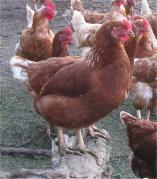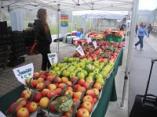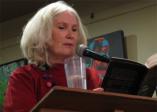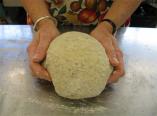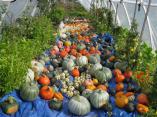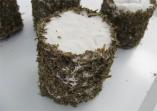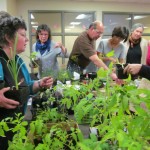 Wednesday’s fun was the GTUF plant swap, at which we shared around our surplus plant starts. It was our monthly meeting and this time the theme was growing and cooking herbs. A couple of our members – Donna Neve & Gene Monast – presented a wealth of information about the power of such herbs as sage and rosemary and extolled their many benefits – ease of growing, beauty in knot gardens and the like, and offered some delicious ways to use them, in breads, cookies and other baking. Then we pushed our chairs back and set to gathering plants for our gardens. Many of the starts had been grown from seeds shared at our seed swap back in January, so the plants go round and round the neighbourhood.
Wednesday’s fun was the GTUF plant swap, at which we shared around our surplus plant starts. It was our monthly meeting and this time the theme was growing and cooking herbs. A couple of our members – Donna Neve & Gene Monast – presented a wealth of information about the power of such herbs as sage and rosemary and extolled their many benefits – ease of growing, beauty in knot gardens and the like, and offered some delicious ways to use them, in breads, cookies and other baking. Then we pushed our chairs back and set to gathering plants for our gardens. Many of the starts had been grown from seeds shared at our seed swap back in January, so the plants go round and round the neighbourhood.
More plants were on offer at Haliburton Farm on Saturday, when the farmers set out a large display of vegetable and berry starts as well as succulents, ornamentals and native plants. The farm now includes five farming businesses, an organic seedling greenhouse and an organic native plant business, so it’s thriving and developing in interesting ways.
Last night I went to hear Karin Kilpatrick talk about healing with plants. She is the medically-trained partner of the amazing herbalist and food forester Richard Walker, who’s in town this weekend to give another of his dazzlingly informative and wide-ranging workshops on food forests. Karin is a doctor who’s worked emergency rooms and general practice in South Africa and rural Canada, and she told us about the “trance-breaking” first encounter with Walker, when he transformed one of her patients from “raw meat” stage eczema to perfect skin in two weeks using diet and herbal tea (the magic food was kicheree, and the tea was dandelion).
She has watched the vibrant health of rural Canadians plummet over the past thirty years of her medical practice and she is categorical in her diagnosis: inflammation, depleted immune systems and accelerated aging brought about by malnutrition. “You don’t give the immune system the right food,” she said, “and it loses.”
But our bodies are exhausted too by the stress of working and living in an oppressive system. The strain of working in increasingly demanding jobs with dwindling budgets takes its toll even from doctors: the pay-per-patient system imposed on GPs “keeps us all in serfdom,” explaining that after office and staff costs are taking into consideration she earns $7 per patient. In reducing patients to the sum of their parts, “it’s reductionist and dehumanizing.”
All colonization systems begin to take control of populations by taking away food autonomy, she observed, pointing to the way “we were sold a bill of goods: cheap, centralized food. We ate it and we got sick.” We do not live in a system where growing your food and healing yourself has a dollar value, and we live in a culture in thrall to monetary reward, so nothing will change unless we change ourselves.
She has changed her life, and sworn off the 10-minute rule for patient consultation. She takes fewer patients and spends longer with them, and she brings the chronically ill together in circle groups for extended education on how to nourish themselves back to health. She meets with them for an hour and a half each week, for 28 weeks, to teach them about nutrient-dense foods, stress management and natural cures for their conditions. “And I’m making my rent,” she added proudly.
Showing her roots – as a South African and as an allopathic doctor – she told us she had one day realized that she was guilty of “apartheid towards plants”. But she was not alone in this: all those who do scientific studies on plant remedies are guilty, because they don’t examine the effects of the whole plant as indigenous cultures do. Instead, science in its reductionist way seeks to find the “active ingredient” and extract that for study. And so of course the results are skewed (as Michael Pollan reported in In Defense of Food, in his discussion of nutritionism and the tragic misuse of plant compounds like beta-carotene instead of whole foods).
The most actively entertaining part of the evening came when we passed a bottle of Spilanthes (tincture) around the room and sampled for ourselves a powerful traditional antifungal, anti-inflammatory and analgesic remedy with some unusual properties, including tremendous qualities in stimulating saliva production. It may, we were warned, remind you of childhood experiments in putting a 9 volt battery in your mouth. And it certainly did fizz and sparkle on the tongue, lips and gums – Karin swears by it for dental hygiene and says it cured her abscessed tooth in days, and a patient’s cold sore in front of her eyes.
Anything more we can do to change the world? someone asked. Her answer was simple. Tell your health care system administrators that you want naturopathy, herbalism and other health-promoting practices included in health care coverage, so that we’re not just paying to treat sick people, but to make good health available to everyone.


